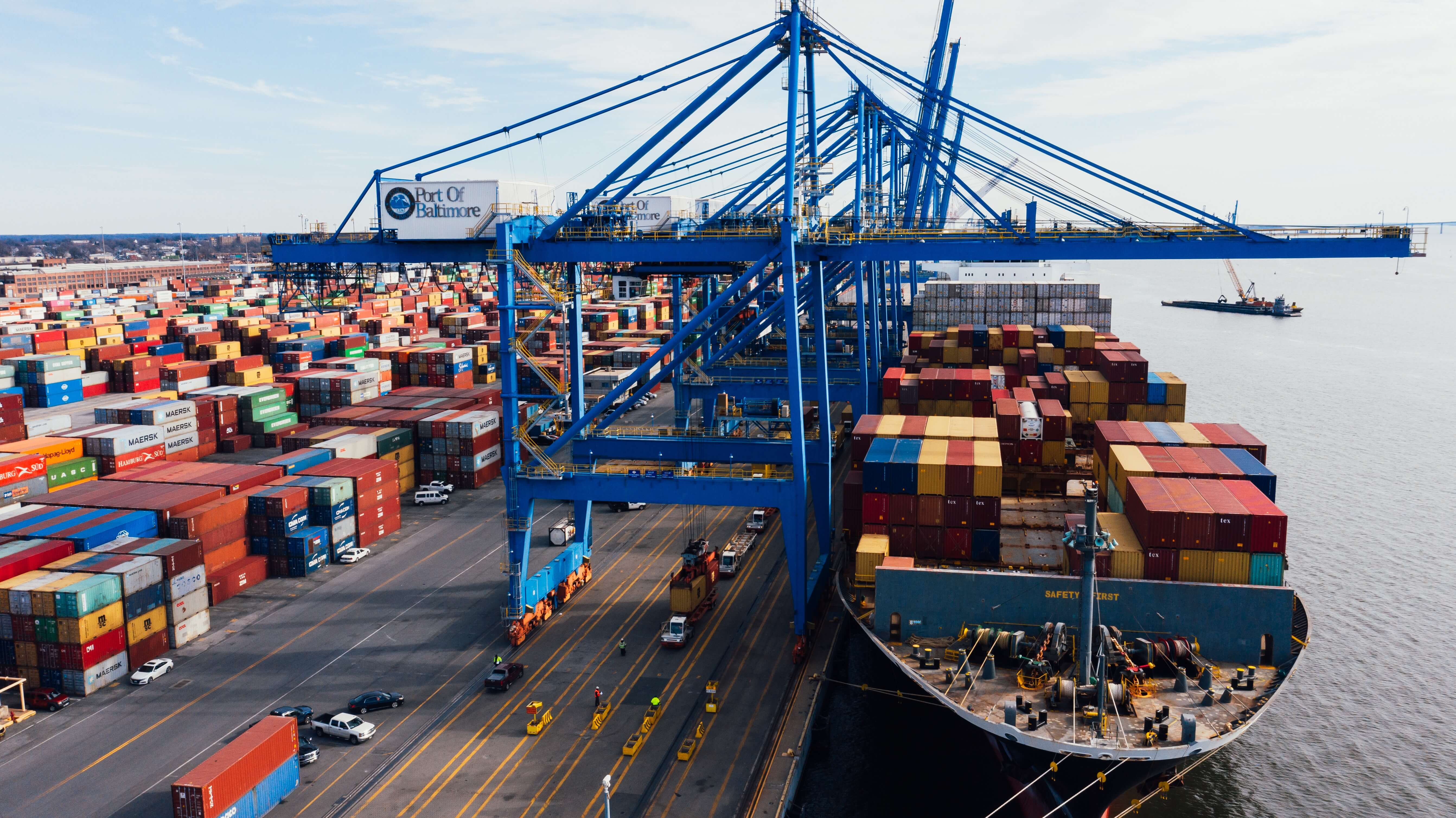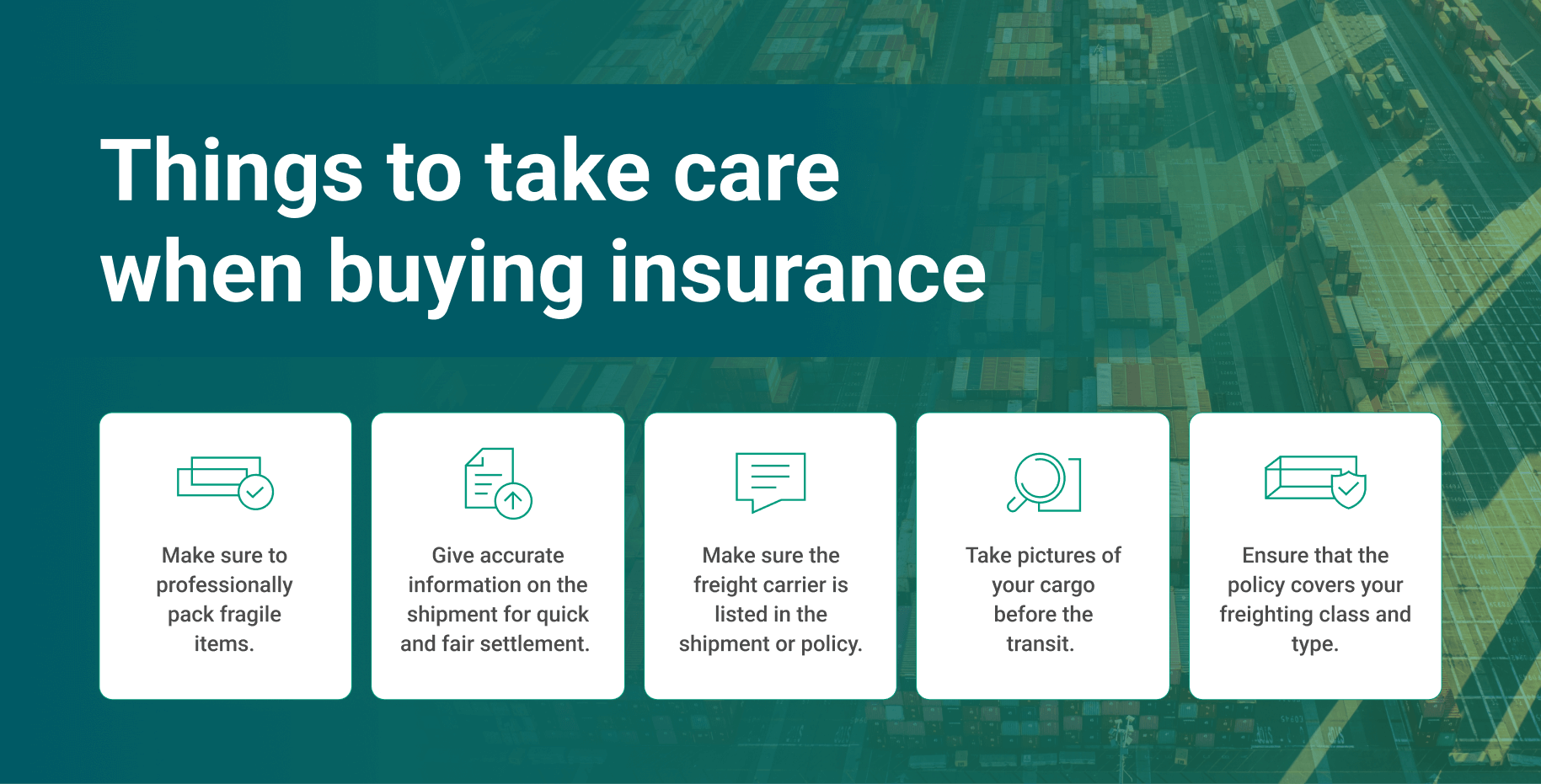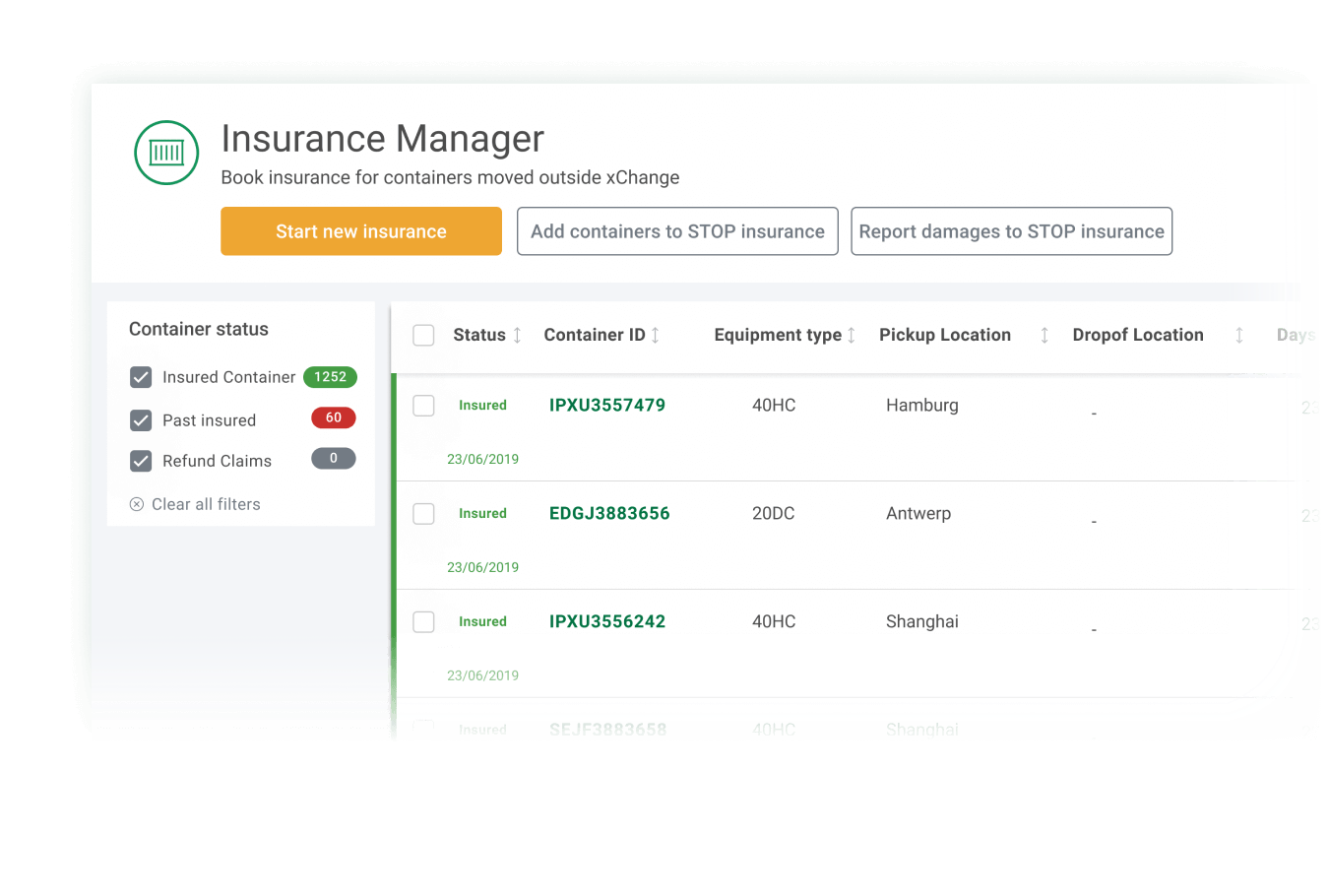Last updated: 19 October, 2023
Your cargo and container can easily damage in transit. Read this blog to learn how you can completely recover the cargo loss with freight insurance. Plus find the most competitive container insurance in the market today.
As a shipper, your priority is to ship your cargo safely, timely, and efficiently. Sadly, accidents happen that may damage your cargo. And they’re hard to predict.
This doesn’t mean you have to bear the loss. Stay ahead of the game by getting freight insurance. Depending on what kind of policy you choose, you can recover part of, or even the total value of your cargo. Phew!
But don’t just stop right there. Damage to your cargo means damage to your box too. Whether you’re a freight forwarder, a container owner, or a user, the liability of container damage can be a real burden. Plus, a massive financial disadvantage!
Container insurance protects both container owners and users. xChange offers Total Damage Insurance and Container Damage Insurance to its members. Click on the banner to learn how to protect your containers from a variety of risks.
What is freight insurance?
Freight insurance is a policy that gives partial or total protection against losses caused to the cargo during transit. As we have seen, problems can occur at any point of the shipping journey. Your cargo might get damaged due to errors in loading, unloading, and trucking, faulty packaging, and weather-related issues. Or, your shipment can even get stolen or lost.
And, unfortunately, these accidents are more common than you think. Read this blog to get an overview of different kinds of damages.
Usually, a standard insurance by carriers will only offer you a blanket amount as coverage. This amount may not recover the true value of your precious cargo. Imagine if your high-value shipment of electronic goods gets damaged and you’re not even able to recover half its value. Won’t that leave you frustrated?
To avoid this, shippers buy freight insurance from third-parties. Such independent insurance policies help you regain the true value of your freight. Also, you don’t have to go through the painful process of proving liability if the damage occurs. The claim will be handled directly by you and the insurance company.

Why do you need insurance for freight?
This is a very important question. Do you need insurance for shipping? Yes. But is it compulsory? No.
Let’s understand this dilemma. As a shipper, you are not mandated to insure your freight. You are legally allowed to ship your goods without any insurance policy. On the other hand, the carrier will provide you some coverage — not insurance — in the form of freight liability. We’ll learn about it in the next section.
So you must be wondering: Why should I sign up and pay a premium for additional coverage? The truth is, you are the best person to insure your shipments’ security. Even though the carrier or the transportation service offer you some coverage, they don’t essentially want the liability of the damage.
As a shipper, you own the value of the cargo. And you can only truly recover from its loss when you are less dependent on these services for coverage.
How freight insurance can save you money
Here’s a quick example of how using the right insurance can save you a lot of money.
48 containers were leased out to one of our customers, of which 38 units returned heavily damaged. The overall repair estimate proposed by the depot was US $34,648.3.
Thanks to Premium Insurance booked by the user, xChange was able to organize a neutral 3rd party survey, which determined that the depots were overcharging and suggesting unnecessary repairs. The actual damage was the limited to US $26.578.
Insurance covered US $11,000 of the impact damages, minimizing the amount the customer had to pay to just US $15,000. With Premium Insurance, the customer was able to save US $19,648!
Next, let’s go over the distinction between freight insurance and freight liability.
Freight insurance vs. freight liability: Major differences
People often think that freight liability and freight insurance are the same thing. But they’re not. It’s easy to get confused, especially when there’s too little information on both these topics.
Freight liability is, essentially, a limited coverage offered by carriers. This coverage amount is based on the type of goods and carrier’s tariff. It doesn’t insure the entire value of your cargo. And getting the coverage amount is not as simple as it sounds.
You should know that freight liability is designed to protect the carrier more than the shipper. All the regulations, rules, and laws will favor the carrier. You’ll have to prove the carrier’s liability. And the carrier can, in fact, challenge all of your claims. So, it can be tricky to come out on top. Plus, it can take over a year to process the freight liability coverage.
With freight insurance, all processes are quick and easy. You don’t have to worry about getting your claim approved. It gets settled within 30 days. What’s more, you don’t have to prove the carrier’s liability. The safety of your cargo is assured.
Things to consider when buying freight insurance
Having said that, you have to be extremely careful with the process of freight insurance. Make sure that you aren’t missing out on anything. And it all starts with reading the fine print. Only sign a policy that covers all of your needs.

There are a few things you need to ensure for a seamless process of filing a claim and receiving freight insurance coverage. Let’s look at them briefly.
- Your claim may be denied if your insurance policy doesn’t specify the freight class and type. Make sure that you have all your terms covered in the policy.
- Buy the policy well in advance, and make sure the carrier is listed in the policy.
- Make sure to professionally pack fragile items such as glass, marble, and granite.. The insurance company will need evidence in the form of packing receipts and photos before releasing the claim.
- Only declare the true value of your shipment. If the declared value differs from the true value, the claim settlement might be reduced.
- It’s best to take photos of your cargo and container before transit. The photos will help the insurer analyze the extent of damage.
Additionally, you’ll also have to confirm that your goods are insurable in the first place.
How to buy freight insurance
And now the big question: How to go ahead and choose insurance for your freight? Since there’s no standardized insurance policy for freight, there’s a good chance you’ll need to have a bit of a back-and-forth.
There are several insurance companies offering freight insurance. Just make sure you negotiate the terms for the policy to work for you. As a rule of thumb, read the policy, just as you would for any other insurance.
We understand that it can be overwhelming. Instead of getting the policy on your own, you can even seek help from an insurance agent, broker, and freight forwarder.
An insurance agent will not only shortlist policies that suit you best, but also review them to make sure you’re covering all of your bases. Whereas, a freight broker and freight forwarder can recommend you and put you in touch with vetted insurance companies.
It’s time you also considered investing in container insurance. In most cases, the cargo gets damaged along with the container. So you’re looking at double the loss. With container insurance, you’re able to safeguard yourself by getting coverage for the container. To put it simply, your freight insurance will protect your cargo and container insurance will protect the equipment.
Shipping container inspection checklist
When inspecting a container for damages, there’s a number of important things you need to look out for. Here’s a quick checklist:
Outside/undercarriage: Check for an structural damage, dents or holes. Make sure the support beams are visible, and that no foreign objects are mounted on the container.
Doors (interior and exterior): Ensure all locks are in good working order and effective, hinges are secure and that no bolts are loose.
Right & left container sides: Check for any unusual repairs to structural beams and any signs of false walls or hidden compartments.
Front wall: Interior blocks in top left and right corners should be visible, as well as vents. Check for signs of a false wall or hidden compartment.
Ceiling & roof: Make sure support beams and ventilation holes are visible. Check that no foreign objects are mounted on the container. Check for signs of a false ceiling or hidden compartments.
Floor: The floor must be flat, clean and dry. Check for unusual repairs, false floors or hidden compartments.
Now that you know how to run through the container inspection checklist, let’s look at how to get freight insurance.
Get container insurance on Container xChange
Shippers can end up in a tough spot financially when containers are damaged. Many shippers avoid container insurance to save costs. But once the container gets damaged, it becomes difficult to figure out who’s responsible. This is where things can turn ugly.
A freight forwarder without insurance might have to pay the entire value of the container and the cargo in case of a total loss. This is a huge financial disadvantage and inconvenience. You don’t want to end up in that tight spot.
So, all container owners, lessors, and operators should get container insurance. Head over to this article to learn about container insurance in detail.
If you want to kick start the process of container insurance, then look no further. xChange offers container insurance for all containers— even the units that are not on the platform.
Our leasing members can simply head over to our Insurance Manager dashboard, make a request to insure containers (even in bulk), select the premium, and get going. Yes, it’s that simple!

Booking container insurance is not only easy and convenient, but also cost-efficient on xChange. We offer you a competitive market price for container insurance. Plus, we’ll help you through each step of the damage claim process.
Two types of container insurance
At Container xChange, you can benefit from two types of container insurance:
- Total Loss Insurance
Total Loss insurance, also called Basic Insurance, protects containers from total loss. The policy covers constructive total loss, general average, and mysterious disappearance. The insurance is valid for one-way moves up to 60 days from the pick-up date. It’ll automatically renew if the container hasn’t returned within the insurance term.
- Container Damage Insurance
Container Damage insurance, also called Premium Insurance, protects containers from total loss and all other kinds of container damage. Containers can get damaged in many ways. This policy gives you coverage for such damages that occur during one-way moves up to 60 days from the pick-up date. It’ll automatically renew if the container hasn’t returned within the insurance term.
We’re sure you have a lot of questions, especially about the coverage and insurance costs. Make a list of all the questions you have and ask our experts to answer them all for you. Just click on the banner below to learn how 1000+ members are benefitting from container insurance on xChange.
Freight Insurance: Common FAQs
What do you mean by freight insurance?
Freight insurance is a policy that gives partial or total protection against losses caused to the cargo during transit.
What is the difference between freight and cargo?
The word 'freight' describes goods. It also refers to the process of transporting goods. Freight are typically carried by smaller vehicles. Whereas, the term 'cargo' describes goods that are carried by ships and planes.
Who is responsible for freight insurance?
Shippers buy freight insurance from third-parties. Such independent insurance policies help them regain the true value of the freight. The claim will be handled directly by shippers and the insurance company.


